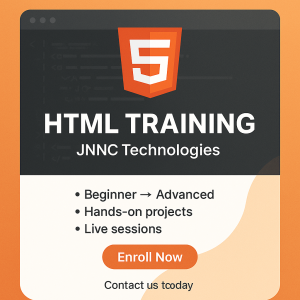
html institute in vizag.
Learn HTML
Start at the beginning by learning HTML basics — an important foundation for building and editing web pages.
About this course
Fun fact: all websites use HTML — even this one. It’s a fundamental part of every web developer’s toolkit. HTML provides the content that gives web pages structure, by using elements and tags, you can add text, images, videos, forms, and more. Learning HTML basics is an important first step in your web development journey and an essential skill for front- and back-end developers. html institute in vizag

Skills you’ll gain
-
Structure pages with HTML
-
Present data with tables
-
Write cleaner HTML
Learn about HTML elements and structure, the building blocks of websites.
Introduction to HTML
Welcome to the world of code! Last year, millions of learners from our community started with HTML. Why? HTML is the skeleton of all web pages. html institute in vizag It’s often the first language learned by developers, marketers, and designers and is core to front-end development work. If this is your first time touching code, we’re excited for what you’re about to create. html institute in vizag
So what exactly is HTML? HTML provides structure to the content appearing on a website, such as images, text, or videos. Right-click on any page on the internet, choose “Inspect,” and you’ll see HTML in a panel of your screen.
HTML stands for HyperText Markup Language:
- A markup language is a computer language that defines
Preparing for HTML
Now that we’ve learned about some of the most common HTML elements, it’s time to learn how to set up an HTML file. html institute in vizag
HTML files require certain elements to set up the document properly. We can let web browsers know that we are using HTML by starting our document with a document type declaration. html institute in vizag
The declaration looks like this:
<!DOCTYPE html>
This declaration is an instruction, and it must be the first
Tables
Learn all the syntax you need to create tables in your HTML documents.
Introduction to Tables

There are many websites on the Internet that display information like stock prices, sports scores, invoice data, and more. This data is tabular in nature, meaning that a table is often the best way of presenting the data. html institute in vizag
In this part of the course, we’ll learn how to use the HTML <table> element to present information in a two-dimensional table to the users.
Let’s get started!
Forms
Take this course and learn about the inner workings of an HTML form! Learn how to create your own form and integrate HTML5 validations. html institute in vizag
Introduction to HTML Forms
Forms are a part of everyday life. When we use a physical form in real life, we write down information and give it to someone to process. Think of the times you’ve had to fill out information for various applications like a job, or a bank account, or dropped off a completed suggestion card — each instance is a form!
Just like a physical form, an HTML <form> element is responsible for collecting information to send somewhere else. Every time we browse the internet we come into contact with many forms and we might not even realize it. There’s a good chance that if you’re typing into a text field or providing an input, the field that you’re typing into is part of a <form>!
In this lesson, we’ll go over the structure
Introduction to HTML Form Validation
Ever wonder how a login page actually works? Or why the combination of a username and password grants you access to a website? The answers lie in validation. Validation is the concept of checking user provided data against the required data. html institute in vizag
There are different types of validation. One type is server-side validation, this happens when data is sent to another machine (typically a server) for validation. An example of this type of validation is the usage of a login page. The form on the login page accepts username and password input, then sends the data to a server that checks that the pair matches up correctly. java training in vizag
On the other hand, we use client-side validation if we want to check the data on the browser (the client).
Semantic HTML
Write clearer, more accessible HTML using Semantic HTML tags.
Introduction to Semantic HTML
When building web pages, we use a combination of non-semantic HTML and Semantic HTML. The word semantic means “relating to meaning,” so semantic elements provide information about the content between the opening and closing tags. html institute in vizag
By using Semantic HTML, we select HTML elements based on their meaning, not on how they are presented. Elements such as <div> and <span> are not semantic elements since they provide no context as to what is inside of those tags.
For example, instead of using a <div> element to contain our header information, we could use a <header> element, which is used as a heading section. By using a <header> tag instead of a <div>, we provide context as to what information is inside of the opening and closing tag.
Projects in this course
-
practice Project
Fashion Blog
It’s time to build fluency in HTML Fundamentals. In this next project, we’re going to practice Structure in HTML so you can hone your skills and feel confident taking them to the real world. Why? This project will help you to understand and master the building blocks of a webpage. It’ll all build up from these foundations. What’s next? A blogger, a developer, a stylish website. You got this! data analyst course in vizag
-
practice Project
Wine Festival Schedule
In this project, we’re going to practice tabular organization in HTML so you can hone your skills and feel confident taking them to the real world. Why? If you’re going to have data on a webpage, you’ve got to master the skill of effectively and aesthetically organizing it – an HTML table is the perfect solution. html institute in vizag
-
practice Project
Form a Story
Use your knowledge of HTML forms to collect input users and put a spin on a classic story!
Frequently asked questions about HTML
-
HTML (HyperText Markup Language) is the skeleton of all modern web pages. Together with CSS and JavaScript, it forms the foundation of modern web development. html institute in vizag
-
HTML gives a web page its structure. It’s used to organize, format, and display a web page’s content (like text, images, videos, and even games). HTML also makes it easier to navigate through the internet through hyperlinks.
-
-
HTML is a must if you’re considering a career in web development, whether you want to become a Front-End, Back-End, or Full-Stack Developer. It can also be helpful for Web Designers, UX Designers, and Marketers.
-
After mastering the basics of HTML, you’ll want to learn CSS to give your web pages some style and JavaScript to add interactive functionality.
-
There aren’t any prerequisites to learning HTML, so you can jump in and start building web pages.


 Previous Post
Previous Post Next Post
Next Post